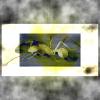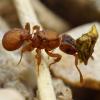So on the topic of ants helping each other, I heard about this research.
https://www.journals...&journalCode=an
Veromessor pergandei workers rescue their siblings, groom off the web, and also dismantle the spider web. Apparently this sort of behavior is rare (???), which is weird because isn't it normal for ants to come to help their sisters or cover sticky stuff with sand or stuff like that? Oh well.
The other scary bit I'm going to quote here.
"V. pergandei colonies include tens of thousands of short-lived workers. To maintain their size, large colonies must collect enough seeds to produce 650 new ants each day."
This makes me really a little concerned about having a polygynous Veromessor pergandei colony when my SINGLE queen colony is already getting scarily uppity and aggressive about trying to escape.














